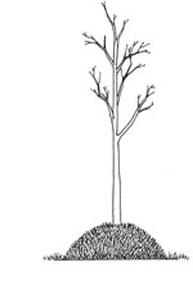Mulching around trees, especially newly planted ones, is a good thing. It keeps down weeds and eliminates competition for nutrients and water. It protects roots from heat in the summer and keeps the ground frozen in the winter. Organic mulch breaks down and provides added nutrients to the soil. It slows the evaporation of water from the soil surface eliminates the need for some watering. However, what is good can also be bad when overdone.
We were in State College recently and saw mulch piled up about a foot up the trunk of some small trees to form a mini mountain. Lest anyone think that this was done by Penn State’s ground crews, it was in the parking lot of a commercial establishment. This is a bad, bad thing and it is difficult to believe that any professional landscaper would be guilty of it.
Mulch should never be allowed to come in contact with the trunk of a tree. It encourages insects and fungi. Rodents, such as voles, can take up residence and damage the tree. Lack of air and proper drying of the tree trunk can lead to the rotting of the bark. The conical distribution of the mulch can cause rain to run off and away from the roots. If the mulch is too deep water won’t get through and lack of air can suffocate the roots.
Never use more than two inches of mulch near the base of a tree and try to keep it from coming in contact with the trunk. It is actually probably better to leave a foot or so unmulched area around the trunk. The same is true of dirt; never mound up dirt around a tree trunk. Good mulching practices can encourage your trees to flourish. Bad ones can be disastrous.

